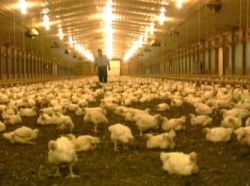
wtocIndustrial chicken farmers are the most impacted by corporate consolidation.
When you sit down to your Thanksgiving dinner, I encourage you to give a thought to the people who grew the food on your table. Did they get a fair shake when they took their bounty to market? For the vast majority of Americans who shop at traditional grocery stores and supermarkets, which are supplied by large distributors and packers, the answer is probably no.
As we’ve noted in our coverage of the recent Food and Water Watch report on the consolidation of our food system, “The Cost of Monopolies” [PDF]:
According to a 2007 study [PDF] from the University of Missouri, the four largest companies controlled 82 percent of the beef packing industry, 85 percent of soybean processing, 63 percent of pork packing, and 53 percent of broiler chicken processing. In fact, so much consolidation has taken place throughout the food chain that it can be difficult for any one person to fathom the true effects.
The negative effects of this consolidation — on the environment, jobs, and income — in rural communities are tremendous. Yet for the last few decades, the government actively encouraged consolidation so that food production and distribution could benefit from economies of scale. Farmers complained about growing abuses from the handful of large companies that came to dominate food processing and distribution (and retailing) — but never seemed to make headway with government regulators.
And that’s because low prices at the supermarket became the Holy Grail of federal policy. Nothing else mattered. We have a system designed to generate huge amounts of cheap food, no matter the collateral damage to the communities where this food is grown or processed.
This approach conveniently ignores the other side of the equation: food producers, who often can’t reach consumers directly and have a desperately hard time getting a fair price for their products when there are only one or two buyers. And those suffering producers are Americans, too, trying to make a living (so they can buy other Americans’ products and services).
Consumers have been pitted against producers. As a consequence, rising prices aren’t greeted as a sustainable development for producers, they’re treated as a symptom of a market that’s not “working.”
But in 2009, farmers finally caught the attention of the federal government when the Obama administration sent representatives from the Departments of Agriculture and Justice — including Attorney General Eric Holder and USDA Secretary Tom Vilsack themselves — out into rural communities to register farmers’ complaints. The blog Civil Eats described the struggles they voiced:
Across the country, the stories have been the same: grain prices so low they don’t cover the cost of [fertilizer and pesticides]. Milk prices so low they don’t cover feed costs. Non-genetically modified seed harder and harder for organic farmers to find. Families forced to sell their farms after generations on the land. Former farmers struggling with debt and unable to find work because they have no off-farm skills. Low-income consumers — urban and rural — with no access to fresh food.
But as Lina Khan documents in her must-read article in Washington Monthly, the federal attempt to create fair markets ultimately stalled out in 2010. In the face of corporate lobbying and the strident opposition of the House GOP majority, the process was defunded, and, in response to corporate and Tea Party outrage, the White House itself watered down the proposed fixes.
Yet as Khan explains, the real culprit wasn’t Barack Obama or John Boehner. It was Ronald Reagan:
Traditionally, the goal of antitrust legislation had been to promote competition by weighing various political, social, and economic factors. But under Reagan, the Department of Justice narrowed the scope of those laws to promote primarily “consumer welfare,” based on “efficiency considerations.” In other words, the point of antitrust law would no longer be to promote competition by maintaining open markets; it was, at least in theory, to increase our access to cheap goods.
This radical change in federal policy transformed the market. Decades of antitrust enforcement in meatpacking, for example — which had ensured that the four largest meatpackers controlled a mere 25 percent of the market in 1976 — were totally undone. Today, the top four meatpackers control 82 percent of the market.
Khan explores in detail what this consolidation means for chicken farmers, 90 percent of whom don’t really own the birds they’re raising, but essentially rent them from processing companies. However, the farmers are still responsible for investing hundreds of thousands of dollars in equipment and feed, specified by their contract with the company, in order to raise the chicks to maturity. And after all that, the processing company can refuse to buy back the birds if it decides the farmer hasn’t lived up to the terms of the contract. With no alternative buyer, the farmer often eats the loss — and sometimes loses the farm.
As I’ve previously reported, chicken farmers have it so bad that many livestock farmers dread what they call the growing “chickenization” of the rest of the business. And the contracts are so restrictive that, as Khan points out, they often contain terms to prevent farmers from speaking about them publicly.
Yet despite the risks to their livelihood, many farmers did speak their minds to the administration back in 2009, during the federal listening tour that was meant to be the basis for system-wide change. In the end, little more came of it than a particularly depressing government report [PDF].
After the Tea Party killed the process — in fairness, aided by a handful of farm-state Democrats, particularly Minnesota’s Rep. Collin Peterson (the man who also led the charge against his own party’s climate change legislation) — and the White House gutted the USDA’s proposals, Justice Department antitrust officials realized that they couldn’t “enforce” their way out of the problem by themselves. Khan writes:
[T]oday, enforcers say they are handicapped even when confronting markets that are no longer competitive. “However desirable, today’s antitrust laws do not permit courts or enforcers to engineer an optimal market structure,” the DOJ wrote in its recent report on the 2010 agriculture hearings. Far-reaching actions — like the Wilson administration’s challenge of the meatpacking industry ninety years ago — are, they say, simply unimaginable under today’s narrow antitrust framework.
There is, however, a cruel logic operating here. After all, in a society that is unable and unwilling to do what’s necessary to generate wage growth for the middle class, cheap food becomes a necessity — and these corporate behemoths have, if nothing else, delivered that. But it’s also a triumph of the conservative vision of a “better them than us” economy as opposed to the progressive vision that we’re all in this together.
So what do to? Promoting alternatives to the industrial system for farmers is a start. The Union of Concerned Scientists just produced a report demonstrating that struggling conventional dairy farmers could thrive by switching to organic production, which would also provide environmental benefits to their communities.
But if we really want to change things, more of us have to begin to see the people who produce our food as if they’re just like us — deserving of fair wages and good food. Because at the moment, many of us are acting as if farmers are merely our competitors for a piece of a shrinking pie.



